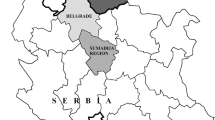Abstract
The serum selenium and the whole blood selenium of 72 healthy persons (47 women, 25 men) was determined. There exist sex specific differences of the whole blood selenium between men (98±19 μg Se/L) and women (89±17 μg Se/L). The serum selenium did not show sex specific differences, but sex specific differences are found if the total amount of extracellular selenium is calculated by correction of the serum selenium with the hematocrit. Women have more extracellular selenium/L whole blood (40±8 μg Se) than men (36±7 μg Se). Men have more intraerythrocyte selenium (cellular selenium=67±14 μg Se) in one L whole blood than women (52±17 μg Se). There exist also sex specific differences if the cellular selenium is calculated/g hemoglobin (men .44 μg Se/g Hb, women .37 μg Se/Hb) or per erythrocyte (men 136.1×10−19 g Se/Ery, women 113.9×10−19 g Se/Ery). In the cellular compartment of one L whole blood on the average 1.56 times more selenium is present than in the extracellular compartment. Most of the intraerythrocyte selenium is hemoglobin bound (84%) and utmost 16% glutathione peroxidase associated. An erythrocyte contains about 3500 mol glutathione peroxidase, or, for every 80000 mol hemoglobin one mol glutathione peroxidase. A standard man needs about 2.5 μg selenium/d for the synthesis of the hemoglobin and the erythrocyte. The hematological parameters hemoglobin and the erythrocyte number are correlated with the cellular selenium and the ratio cellular selenium/extracellular selenium. Positive significant correlations are found that are best if a parabolic model is used to interpret the shape of the curves. From the shape of the best correlation lines it can be concluded that selenium may be beneficial for hemoglobin synthesis and erythropoesis. The extracellular selenium may have influence on the volume of the erythrocyte by protecting the outer erythrocyte membrane from lipid peroxidation.
A method is reported based on the carbon furnace atomic absorption spectroscopy, which is able to determine without wet digestion selenium in whole blood.
Similar content being viewed by others
References
Y. C. Awasthi, C. E. Beutler, and S. K. Srivasta,J. Biol. Chem. 250, 5144 (1971).
L. Flohé, B. Eisele, and A. Wendel,Hoppe Seylers Z. Physiol. Chem. 352, 151 (1971).
Y. C. Awasthi and D. D. Dao,Fed. Proc. 37, 1340 (1978).
O. Oster, E. Batke, and W. Prellwitz, Unpublished results.
Keshan Disease Research Group of the Chinese Academy of Medical Sciences, Beijing.Chin. Med. J. 92, 477 (1979).
Keshan Disease Research Group of the Chinese Academy of Medical Sciences, Beijing,Chin. Med. J. 92, 471 (1979).
P. J. Collipp and S. Y. Chen,N. Eng. J. Med. 304, 1304 (1981).
R. A. Johnson, S. S. Baker, J. T. Fallon, E. P. Maynard, J. N. Ruskin, Z. Wen, K. Ge, and H. J. Cohen,N. Eng. J. Med. 304, 1210 (1981).
O. Oster, W. Prellwitz, W. Kasper, and T. Meinertz,Clin. Chim. Acta 128, 125 (1983).
J. T. Salonen, G. Alfthan, J. K. Huttunen, J. Pikkarainen, and P. Puska,Lancet 175 (1928).
G. N. Schrauzer and D. A. White,Bioinorg. Chem. 8, 303 (1978).
O. Oster and W. Prellwitz,Clin. Chim. Acta 124, 277 (1982).
W. A. Günzler, H. Kremers, and L. Flohé,Z. Klin. Chem. Klin. Biochem. 12, 444 (1974).
E. L. Henn,Analyt. Chem. 47, 428 (1975).
O. Oster and W. Prellwitz, Nordic Symposium on Metabolism of Trace Elements Related to Human Disease, Leon, Norway, 1985.
O. Oster, M. Drexler, J. Schenk, T. Meinertz, W. Kasper, C. J. Schuster, and W. Prellwitz,Ann. Clin. Res. 18, 36 (1986).
J. T. Salonen and J. K. Huttunen,Ann. Clin. Res. 18, 30 (1986).
O. Oster, W. Prellwitz, C. Luley, T. Meinertz, A. Geibel, and W. Kasper, inTrace Element-Analytical Chemistry in Medicine and Biology, vol. 4, p. 579, P. Brätter and P. Schramel, Eds., de Gruyter, Berlin (1987).
C. D. Thomson and M. F. Robinson,Am. J. Clin. Nutr. 33, 303 (1980).
T. Westermark, P. Raunu, M. Kirjarinta, and L. Lappalainen,Acta Pharmacol. et Toxicol. 40, 465 (1977).
J. C. Valentine, H. K. Kang, Phnong-Mai Dang, and G. Spirey, inSelenium in Biology and Medicine, p. 354, J. E. Spallholz, J. L. Martin, and H. E. Ganther, Eds., AVI, Westport, USA (1981).
K. Kasperek, G. B. Iyengar, J. Kiem, H. Borberg, and L. E. Feinendegen,Clin. Chem. 25, 711 (1979).
D. Behne and H. Jürgensen,Radioanal. Chem. 42, 447 (1978).
B. Welz, M. Melcher, and J. Néve,Anal. Chim. Acta 165, 131 (1984).
K. H. Schaller, G. Hampel, C. Oefele, and E. Wilhelm,Spurenanalytik, p. 152, B. Welz, Ed., VCH Verlagsgesellschaft, Weinheim, Germany.
M. A. J. Weber, J. Schuhbeck, K. Theisen, and P. Schramel,Medicine and Biology, Neuherberg, Germany (1985).
E. B. Thorling, K. Overrad, and J. Geboers,Ann. Clin. Res. 18, 3 (1986).
G. N. Schrauzer, D. A. White, and C. J. Schneider,Bioinorg. Chem. 7, 23 (1977).
D. Behne and W. Wolters,J. Clin. Chem. Clin. Biochem. 17, 133 (1979).
M. A. Beilstein and P. D. Whanger,J. Nutr. 113, 2138 (1983).
A. S. Majaj and L. L. Hopkins,Lancet 593 (1966).
J. G. Morris, W. S. Cripe, H. L. Chapman, Jr., D. F. Walker, J. B. Armstrong, J. D. Alexander, Jr., R. Miranda, A. Sanchez, Jr., B. Sanchez, J. R. Blair-West, and D. A. Denton,Science 223, 491 (1984).
M. D. Maines and A. Kappas,Proc. Natl. Acad. Sci. 73, 4428 (1976).
J. D. Rotruck, A. L. Pope, H. E. Ganther, and W. G. Hoekstra,J. Nutr. 102, 689 (1972).
W. Hartfiel, and N. Bahners, VDLUFA-Schriftenreihe, 16, Kongreßband (1985), p. 511, VDLUFA-Verlag, Darmstadt, Germany (1986).
N. Bahners and W. Hartfiel, VDLUFA-Schriftenreihe, 16, Kongreßband, 1985, p. 503, VDLUFA-Verlag, Darmstadt, Germany (1986).
Author information
Authors and Affiliations
Rights and permissions
About this article
Cite this article
Oster, O., Schmiedel, G. & Prellwitz, W. Correlations of blood selenium with hematological parameters in West German Adults. Biol Trace Elem Res 15, 47–81 (1988). https://doi.org/10.1007/BF02990126
Received:
Accepted:
Issue Date:
DOI: https://doi.org/10.1007/BF02990126




